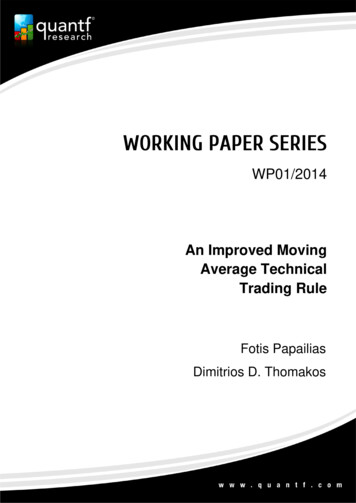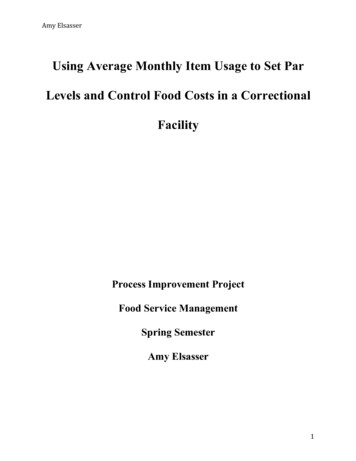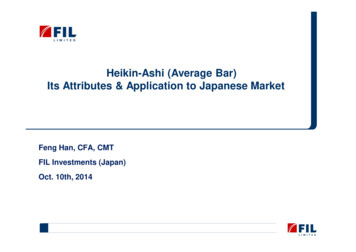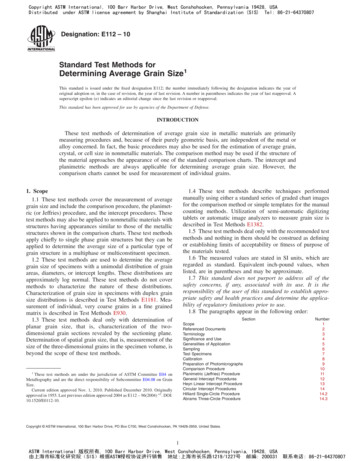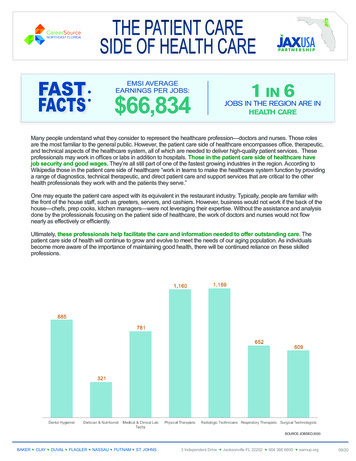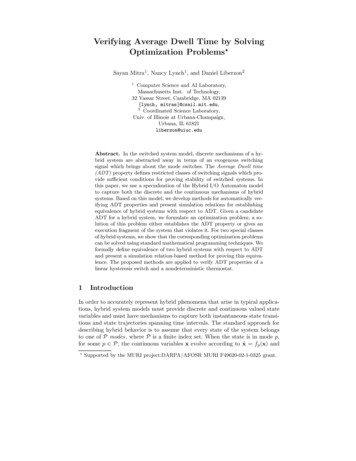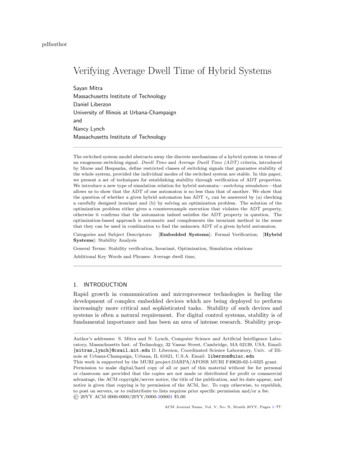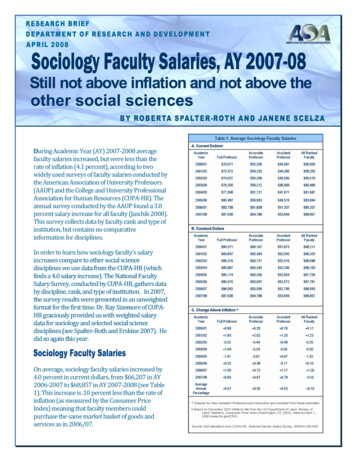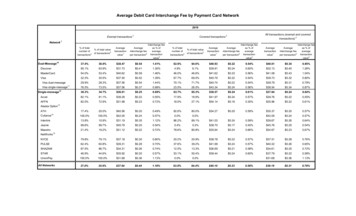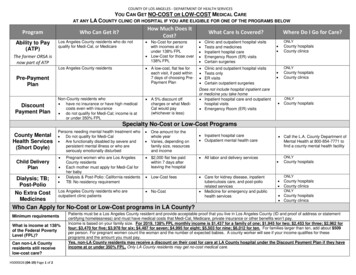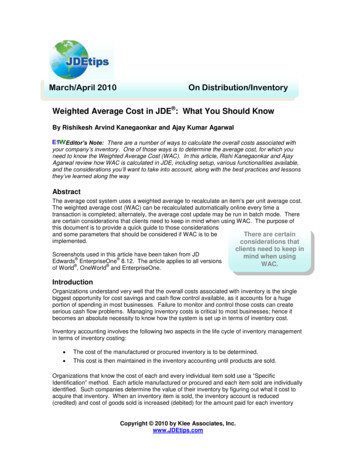
Transcription
March/April 2010On Distribution/InventoryWeighted Average Cost in JDE : What You Should KnowBy Rishikesh Arvind Kanegaonkar and Ajay Kumar AgarwalEditor’s Note: There are a number of ways to calculate the overall costs associated withyour company’s inventory. One of those ways is to determine the average cost, for which youneed to know the Weighted Average Cost (WAC). In this article, Rishi Kanegaonkar and AjayAgarwal review how WAC is calculated in JDE, including setup, various functionalities available,and the considerations you’ll want to take into account, along with the best practices and lessonsthey’ve learned along the wayAbstractThe average cost system uses a weighted average to recalculate an item's per unit average cost.The weighted average cost (WAC) can be recalculated automatically online every time atransaction is completed; alternately, the average cost update may be run in batch mode. Thereare certain considerations that clients need to keep in mind when using WAC. The purpose ofthis document is to provide a quick guide to those considerationsand some parameters that should be considered if WAC is to beThere are certainimplemented.considerations thatScreenshots used in this article have been taken from JD Edwards EnterpriseOne 8.12. The article applies to all versions of World , OneWorld and EnterpriseOne.clients need to keep inmind when usingWAC.IntroductionOrganizations understand very well that the overall costs associated with inventory is the singlebiggest opportunity for cost savings and cash flow control available, as it accounts for a hugeportion of spending in most businesses. Failure to monitor and control those costs can createserious cash flow problems. Managing inventory costs is critical to most businesses; hence itbecomes an absolute necessity to know how the system is set up in terms of inventory cost.Inventory accounting involves the following two aspects in the life cycle of inventory managementin terms of inventory costing: The cost of the manufactured or procured inventory is to be determined. This cost is then maintained in the inventory accounting until products are sold.Organizations that know the cost of each and every individual item sold use a ―SpecificIdentification‖ method. Each article manufactured or procured and each item sold are individuallyidentified. Such companies determine the value of their inventory by figuring out what it cost toacquire that inventory. When an inventory item is sold, the inventory account is reduced(credited) and cost of goods sold is increased (debited) for the amount paid for each inventoryCopyright 2010 by Klee Associates, Inc.www.JDEtips.com
Weighted Average Cost in JDEitem. This method works well when each item is relatively unique and the amount of inventorythat a company has is limited. Companies that use this method might include car dealers, artgalleries, etc.The advantage is that this method is the most precise way of determining inventorycosting/pricing. However, problems arise when a company has a large inventory and eachspecific inventory item is relatively identical to other items. This method is far too cumbersomefor companies with large and even medium-sized inventories. As a result, other inventoryvaluation methods like FIFO, LIFO, and WAC have been developed.The following methods are most commonly used for inventory valuation methods in JDE.1. First-in First-Out (FIFO):The first goods to be sold (cost of sales) are the first goods that were manufactured orpurchased. Under FIFO, it is assumed that the oldest inventory—i.e., the inventory firstpurchased—is always sold first. Therefore, the inventory that remains would logically befrom only the most recent purchases.In this example, a retailer buys 10 bikes from a manufacturer on Monday for 1,000( 100 per bike) and 20 bikes on the next Monday at 3,000 ( 150 per bike).The first 10 bikes that are sold will reduce inventory and increase cost of goods sold at arate of 100 per bike. The next 20 sold will have an inventory price of 150 per bike. It isirrelevant whether a customer actually buys the older bike first. Under FIFO, a companyalways assumes that it sells its oldest inventory first and that ending inventories includemore recently purchased merchandise. Companies selling perishable goods such asfood and drugs tend to use this method, because cash flow closely resembles goods flowwith this method.2. Last-in First-out (LIFO):The first goods to be sold (cost of sales) are the last goods that were manufactured orpurchased. Under LIFO, it is assumed that the most recent purchase is always sold first.Therefore, the inventory that remains is always the oldest inventory. So for the givenexample above, the first 20 bikes that are sold will reduce inventory and increase cost ofgoods sold at a rate of 150 per bike. Again, it does not matter if customers actually buythe newer bikes first. Under LIFO, a company always assumes that it sells its newestinventory first. This method represents the true flow of goods for very few companies.3. Average Cost:This method requires that companies should calculate the average unit cost of the goodsin the beginning inventory for that period plus the purchases made in the period.Average cost is determined by dividing total costs on hand by total units on hand.However, Weighted Average Cost (WAC) is timing sensitive – it recalculates the WACafter every transaction.In the example above, the weighted average cost would be 4,000/30 bikes, whichequals to 133.33 per bike. Therefore, every bike would have the inventory price of 133.33, regardless of whether they were actually bought in the 100 purchase or the 150 purchase. This weighted average would remain unchanged until the next purchaseoccurs, which would result in a new weighted average cost to be calculated. So, theWAC will thus be calculated during each transaction affecting perpetual inventory. Thisinventory accounting method is used primarily by companies that maintain a large supplyof undifferentiated inventory items such as fuels and grains.The advantage of weighted average is that it is hard to manipulate and easy to calculate.Copyright 2010 by Klee Associates, Inc.www.JDEtips.comPage 2
Weighted Average Cost in JDEDividing the total cost of goods available for sale by the total number available for saletends to level out the effects of cost increases and decreases. This is most relevant toorganizations that use such a method of inventory valuation.4. Advanced Stock Valuation:The Advanced Stock Valuation module of JDE is a useful and powerful alternative for anycompany wanting to value its on-hand inventory and also know its cost of sales on aFIFO, LIFO, or Average Cost basis. Advantages of using this system are as follows: With this system, one primary method of stock valuation can be set up per companyto update the General Ledger for standardized accounting and reporting. However,any number of secondary methods can be used for comparison or other reportingpurposes. So it has the flexibility needed to accommodate the many stock valuationmethods throughout distribution industries, allowing you to compile inventory reportsand assess inventory value at the desired level and detail. It precisely calculates any kind of inventory, including stock in transit; loans, borrows,and exchanges; exclusion of commingled inventory; and gains and losses associatedwith bulk stock. This method provides an opportunity to review and analyze results before updatingthe General Ledger. And, with dual currency, stock valuation can be based on astable currency in addition to the domestic currency. It uses period beginning and ending inventory, so it removes the timing effect oftransactions. This is particularly important when inventory goes negative as it doesnot recalculate after every transaction—it uses period beginning and endingbalances, so if both those numbers are positive, there would be no problem withnegative inventory during the period. We will revisit this advantage a little later in thisdocument when we look at the disadvantage of inventory going negative when usingthe WAC method.The focus of this document will be on the WAC system in JDE. We have often heard that if thecosting is set up using the Weighted Average Costing method, then issues multiply; theperception is that keeping track of the true WAC is a pain point because this cost in the system isalways a moving target. In this article, our intent is to provide you with enough firepower tocombat this ―devil‖. In this article, we will:1. Identify the essential setup required for WAC in JDE2. Identify the different WAC Functionality available in JDE3. Discuss the considerations and recommendations for setting up WAC to effectively workwith your set of business rules4. Present best practicesWAC DefinitionLet us start with a definition of Weighted Average Costing (WAC):Simply put, weighted average measures the total cost of items in inventory that areavailable for sale divided by the total number of units available for sale.Copyright 2010 by Klee Associates, Inc.www.JDEtips.comPage 3
Weighted Average Cost in JDEFor example: Let’s suppose you purchased five bikes at 100 apiece and five at 200 apiece.The weighted average is calculated as follows: Five Bikes at 100 each 500 Five Bikes at 200 each 1000 Total number of Bikes 10 Weighted Average Total Cost / Total # of unitsSo, 150 is the WAC of these 10 Bikes ( 1500 / 10 150)However, if you had only two 100 bikes and eight 200 bikes, the calculation would be: Two Bikes at 100 each 2 x 100 200 Eight Bikes at 200 each 8 x 200 1600 200 1600 1800 Weighted Average Total Cost / Total # of units 1800/10 180Although the average of 100 and 200 is 150, the weighted average in this case is 180.These examples are just to highlight how different factors affect the WAC calculation.WAC Setup in JDEBefore we actually dive deep into what considerations you’ll want to take for mapping businessrules, let us take a look at these important setups for WAC:Inventory Cost Level SetupThe Item Master stores the setup of Inventory Cost Level, Sales Price Level, and Purchase PriceLevel. Inventory Cost Level is the level at which overall inventory cost is maintained (see Figure1). There are three levels at which this can be maintained:1 – Item Level2 – Item Branch Level3 – Item Branch Location LevelFigure 1: Inventory CostLevel SetupCopyright 2010 by Klee Associates, Inc.www.JDEtips.comPage 4
Weighted Average Cost in JDEUDC 40 CMIn JDE, WAC is called 02 Cost and is defined in UDC 40 CM. The system calculates andupdates this amount by adding transaction quantities together, adding transaction costs together,and dividing the total cost by the total quantity.Below is the formula that is used to calculate WAC for every transaction that affects inventorycost:WAC [(Qty On Hand x Current WAC) (Trans Qty x Trans Unit Cost)] / (Qty On Hand Trans Qty)Setting up WAC costing method for Sales/Inventory is done in ―Cost Revisions‖ (P4105) on menuG4112. Set the Sales/Inventory cost method to ―02‖ (see Figure 2). All costs are stored in theItem Cost (F4105) file in the primary unit of measurePlease note that the system will calculate WAC whether or not the WAC is used as the currentSales/Inventory cost method. In other words, even if Sales/Inventory cost method is 07(standard), 02 cost (WAC) will still be calculated and tracked in the Item Cost file (F4105).Figure 2: Setting 02Cost MethodSetup for WAC On-LineTo have your WAC recalculated automatically after each transaction, check the ―Update AverageCost On-Line‖ button on the System Constants screen shown in Figure 3 (form exit from branchplant constants P41001).Figure 3: SystemConstants Setting forOnline WAC UpdateCopyright 2010 by Klee Associates, Inc.www.JDEtips.comPage 5
Weighted Average Cost in JDEThe average cost system uses the weighted average to recalculate an item's per unit averagecost. Once this is activated, the WAC can be recalculated automatically on-line every time atransaction is completed.In addition to checking the ―Update Average Cost On-Line‖ box, the programs that impact WACare to be selected on UDC 40 AV. More on UDC 40 AV is explained a little later in theConsiderations section.WAC Can Be Run in Batch ModeSimilarly, the average cost update may be run in batch mode; the Update Average Cost (R41811)is the batch program for updating WAC. It has no processing options and is based on theAverage Cost Work File (F41051). The data selection can be used to select which Items orBranch Plants to update.If you did not check the ―Update Average Cost On-Line‖ box as discussed above, then each timea transaction is completed whose program is listed in the 40/AV UDC table, a record is created inthe Average Cost Work File (F41051). Those records are created regardless of whether WAC isthe current sales/inventory cost method. When the Update Average Cost (R41811) is run, it willpurge the Average Cost Work File (F41051) records that it processed.Factors That Impact WAC ChangeThe WAC that results from several transactions will be the same, regardless of whether you’rerecalculating WAC on-line or in batch. This is an important design parameter from the systempoint of view that ensures that the net result of WAC takes all transactions impacted intoconsideration. The order of the transactions is important because system recalculates WAC afterevery transaction.The recalculation of WAC, either online or in batch, will neither create an IB transaction (inventoryre-evaluation adjustment), nor will it create any journal entries. This is because the system hasnow averaged the per-unit cost of the existing inventory together with the per-unit cost of thetransaction now added into the calculation.However, please note that if the WAC is changed in the Cost Revisions (P4105) program, an IBtransaction will be created that will show
Screenshots used in this article have been taken from JD Edwards . Inventory accounting involves the following two aspects in the life cycle of inventory management in terms of inventory costing: The cost of the manufactured or procured inventory is to be determined. This cost is then maintained in the inventory accounting until products are sold. Organizations that know the cost of each and .
